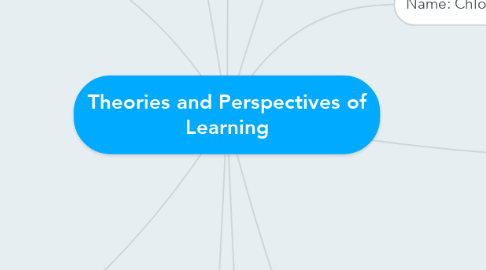
1. Constructivism
1.1. mean: create build our own knowledge
1.2. Piaget
1.2.1. Cognitive (thinking & learning)
1.3. Vygotsky
1.3.1. social (social context)
1.3.1.1. Zone of Proximal Development
1.3.1.2. Scaffolding
1.4. Constructivist Approaches to Teaching
1.4.1. Top-Down Processing
1.4.2. Cooperative & Collaborative Learning
1.4.3. Discovery Learning
2. Theory of multiple intelligences
2.1. Intelligence
2.1.1. Capacity to acquire knowledge and understanding
2.1.2. is not one inborn fixed trait
2.1.3. Have different types
2.1.3.1. Word smart
2.1.3.2. Picture smart
2.1.3.3. Number smart
2.1.3.4. Body smart
2.1.3.5. Music smart
2.1.3.6. Self smart
2.1.3.7. People smart
2.1.3.8. Nature smart
2.2. key features of MI theory
2.2.1. Definition of intelligence based on real-world intelligence
2.2.2. A pluralistic view of intelligence
2.2.3. All eight intelligence are universal
2.2.4. Intelligences are educable
2.2.5. Individuals possess unique profiles of intelligence that develop and change
2.2.6. Each intelligence involves subabilities
2.3. 3 main factors
2.3.1. Biological endowment
2.3.2. Personal life history
2.3.3. Cultural & historical background
3. Motivation and learning
3.1. Types
3.1.1. Intrinsic
3.1.1.1. Autonomy
3.1.1.2. Curiosity
3.1.1.3. Meaning
3.1.1.4. Learning
3.1.2. Extrinsic
3.1.2.1. Badges
3.1.2.2. Competition
3.1.2.3. Fear of failure
3.1.2.4. Fear of punishment
3.1.2.5. Rewards
3.2. Theories
3.2.1. Behavioral Theories of Motivation
3.2.1.1. Examples
3.2.1.1.1. Rewards
3.2.1.1.2. Praise
3.2.1.1.3. Privileges
3.2.1.1.4. Social Recognition
3.2.1.1.5. Obligation Removal
3.2.2. Cognitive Theories Of Motivation
3.2.2.1. Interest theory
3.2.2.2. Goal theory
3.2.2.3. Self-Determination theory
4. Learning styles
4.1. Usually one or two styles are preferred
4.2. Not fixed traits which an individual will always display
4.3. Student do not learn the same way
4.4. Models
4.4.1. Honey-Mumford Model
4.4.1.1. Feeling
4.4.1.2. Observing
4.4.1.3. Thinking
4.4.1.4. Doing
4.4.2. Neuro-Linguistic Model
4.4.2.1. Visual
4.4.2.2. Auditory
4.4.2.3. Kinaesthetic
5. Introduction to learning
5.1. theory
5.1.1. use experience to support evidence
5.1.2. conclude the logic
5.1.3. set of idea
5.1.4. assumption
5.1.5. scholars
5.1.6. analysed
5.2. Main areas of the understanding of learning
5.2.1. Basis
5.2.2. External conditions
5.2.2.1. Learning situation
5.2.2.2. Learning space
5.2.3. Application
5.2.4. Internal conditions
5.2.4.1. Intelligence
5.2.4.2. Individual learning styles
5.3. Types
5.3.1. Beahviourism
5.3.2. Constructivism
5.3.2.1. thinking & learning
5.3.2.2. social context
5.3.3. Cognitivism
6. Behaviourist approaches
6.1. Ivan Pavlov
6.1.1. Classical Conditioning
6.1.1.1. stimulus -----> response
6.1.1.1.1. e.g the dogs have a reflex, and ring the bell, the dog will association.
6.2. Skinner
6.2.1. Operant Conditioning
6.2.1.1. skinner box
6.2.1.1.1. Positive Reinforcement
6.2.1.1.2. Negative Reinforcement
7. Cognitive theories
7.1. cognitive: refers to knowing & thinking
7.2. cognitive concepts
7.2.1. knowledge
7.2.1.1. declarative
7.2.1.2. procedural
7.2.2. flexibility
7.2.2.1. set of goals
7.2.2.2. making decisions
7.2.2.3. using strategies & changing
7.2.3. drive
7.2.3.1. motivation
7.2.3.2. personality characteristics
7.3. cognitive learning theory
7.3.1. information processing theory
7.3.2. schema theory
7.4. key process involved in memory
7.4.1. encoding
7.4.1.1. storage
7.4.1.1.1. retrieval
7.4.1.1.2. memory
8. Experiential learning
8.1. process of engagement inner world and outer world
8.2. Brainstorm
8.2.1. ideas
8.2.2. any thoughts
8.2.3. does not need to be facts
8.3. Kalb's experiential learning cycle
8.3.1. Concrete experience
8.3.2. Reflective obsenvation
8.3.3. Abstract conceptualization
8.3.4. Active experimentation
8.4. Strategies
8.4.1. learning games
8.4.2. action learning
9. Emotions and learning
9.1. Emotions involves
9.1.1. Cognitive
9.1.2. Physiological
9.1.3. Behavioral
9.2. Emotional intelligence
9.2.1. Self-awareness
9.2.2. Self-regulation
9.2.3. Motivation
9.2.4. Empathy
9.2.5. Social skills

